#ancient runes motif
Photo

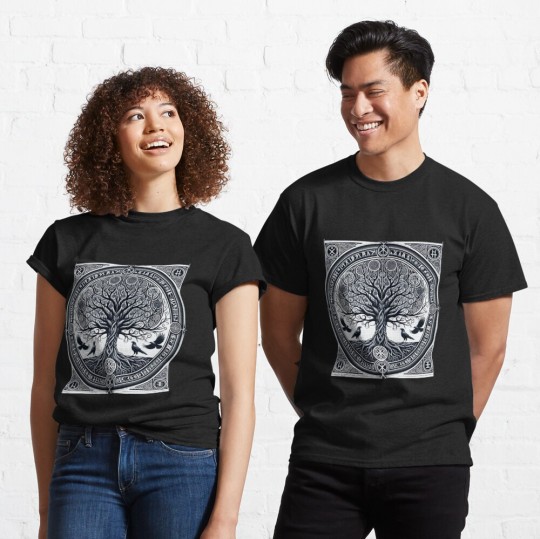
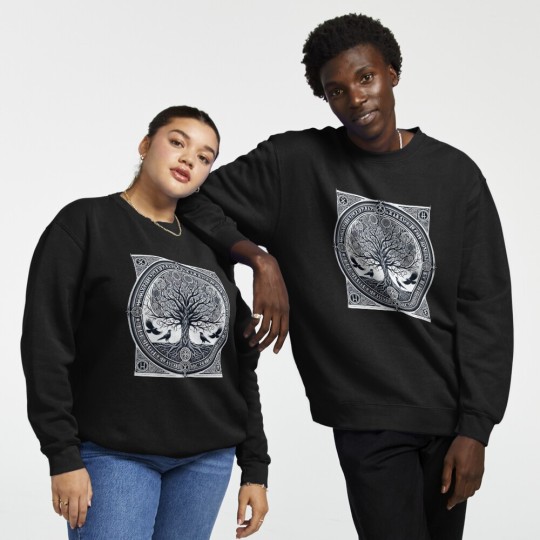



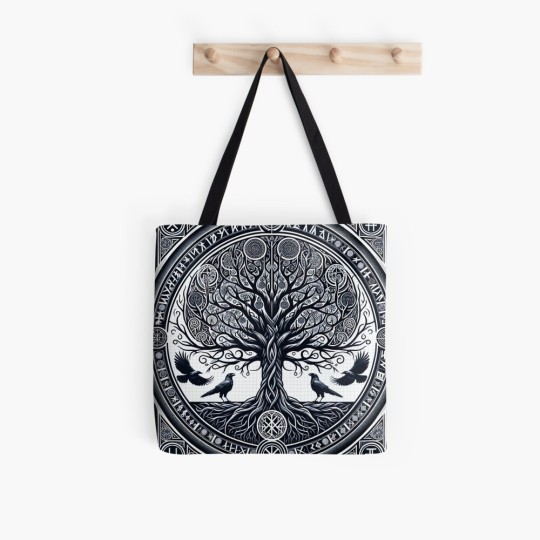
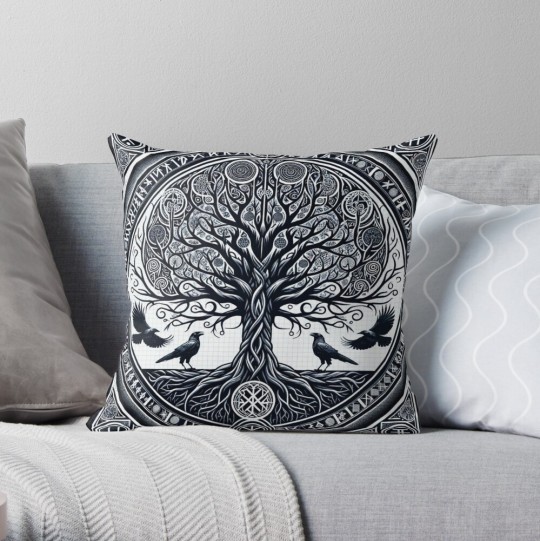
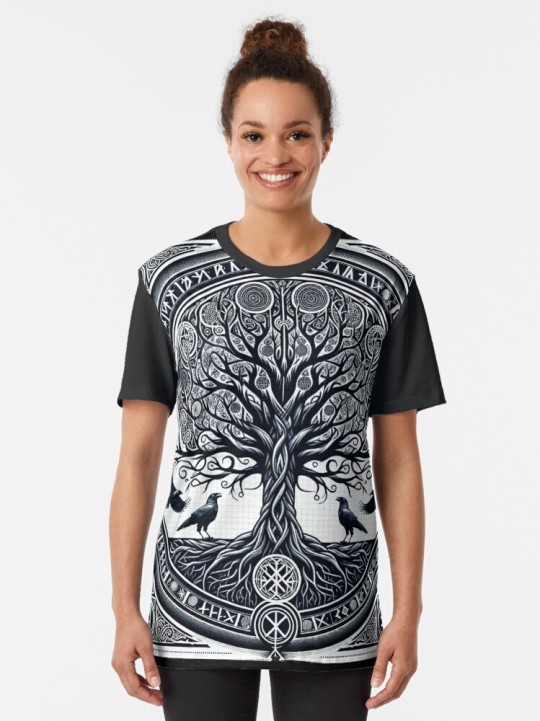

Channel the spirit of the legendary Varangian Guard with our meticulously crafted design. At the heart of this piece lies the mighty Yggdrasil, the tree of life, symbolizing the interconnected nature of all things. Its sprawling branches and roots form an intricate network of patterns, interwoven with Norse runes that hold the secrets of the universe. Nestled within this complex array of Norse iconography, the twin ravens of Odin, Huginn and Muninn, emerge. Their presence captures the essence of foresight and memory, key attributes revered by the Norse gods. This emblem is not merely a design but a portal to the enigmatic world of Norse mythology. Each line, each symbol, is a stroke of history, a piece of a legend brought to life. Embrace the call of the ancients and carry the wisdom of the Norsemen with you. This design does not just adorn; it invokes the power and mystique of the Varangians, making it more than just a visual statement—it's an armor for the modern-day warrior.
(via "Yggdrasil Tree Runes Norse Emblem" Graphic T-Shirt for Sale by ZbigArt)
#findyourthing#redbubble#norse mythology#norse pantheon#varangian guard symbolism#yggdrasil tree design#odinsravens#norse runes#viking mythology fashion#ancient runes motif#warrior guardians graphic#berserker warrior iconography#mythology and folklore
1 note
·
View note
Text
So wait a second...
In official Rune Factory 4 lore, Ventuswill was supposed to die many, many centuries ago. It's uncertain how many, but it's generally accepted that Leon likely became the first Guardian around 1000 years ago. The big thing is that, in theory, Ventuswill's natural lifespan could have been much longer with no need for Guardians or Rune Spheres, but she was born in a land where the runes were beginning to die out and was thus weak. The Earthmates creating the Rune Spheres was as much about restoring runes to the land as it was saving Ventuswill because while the world can go on without Ventuswill, the world cannot go on without runes. Without runes, the land becomes barren, crops won't grow, and all life eventually ends.
Now, I don't know much about Rune Factory 2 since I haven't actually played it (and anyone who has is free to correct me on the below points), but from what I've read online in terms of the lore, Fiersome's apocalypse would have happened a thousand years ago had the ancient Earthmates not placed their seal on him--roughly when Ventuswill was originally supposed to expire. And every thousand years, the seal on him has to be renewed; if not, the world is destined to be destroyed in Fiersome's raging apocalyptic hellfire, after which Terrable will awaken and restore life to the charred landscape at the cost of eliminating whatever remaining life has survived--in other words, a total rebirth of the planet.
Between the close timing of these two past events--the point that Ventuswill's life was originally supposed to end and the point when the seal was placed on Fiersome--and the fact they were to occur when the world's runes were starting to dry up, the Earthmates both past and present have been staving off the inevitable End of the World for centuries. The world, as we know it, could have been destroyed a thousand years ago as it was supposed to, but the Earthmates said "Nope! It's too nice to let it all die!" and have done everything they can to extend its lifespan.
And that's when we get to Rune Factory 5 and an incredibly dark statement from the main antagonist, Gideon. According to Gideon, Alice/Ares is the last known Earthmate--not the last, but there are so few Earthmates that if there are any others left, they're most likely in hiding and are on their way to becoming an extinct species. Now, Ventuswill's longevity has been ensured thanks to the actions of Lest/Frey during RF4 and she'll probably still be munching on pancakes in 1000 years, but if the Earthmates wind up going extinct, there's no way to restore Fiersome's seal because only Earthmates are capable of renewing the magic used to keep him locked up. And Fiersome is not the only godlike creature capable of causing the world's inevitable destruction; Tides of Destiny gave us the Legendary Golem, whose cataclysmic battle with the Native Dragons led to the creation of the current world, and RF5's potential apocalypse was that of the Fathomless Dread, an eldritch abomination that literally had to be sealed in another dimension to prevent it from destroying the world.
The Rune Factory world has brushed time and time again with total annihilation and the only reason it has managed to avoid catastrophe was because there was an Earthmate around to stop it. What happens when there are no longer any Earthmates to stop the end of all? Or is it possible that the Earthmates are going to experience a revival of some sort? Besides a castle-esque design, the logo for Rune Factory 6 does suspiciously feature a seraph/halo motif, after all...

152 notes
·
View notes
Text
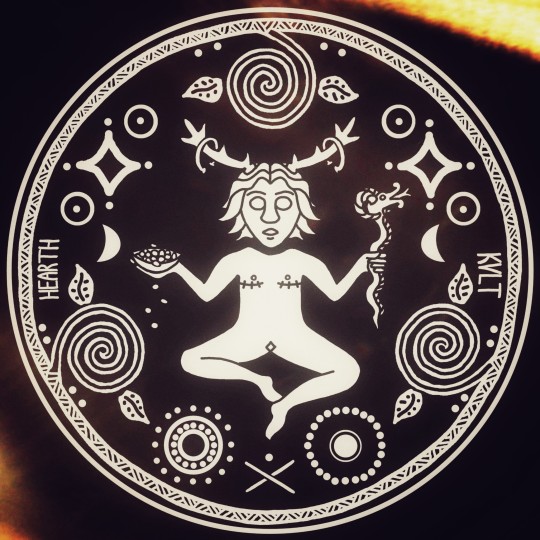
Generosity of Spirit. ✨️ A transmasculine figure stylized after the Celtic deity known as Cernunnos, a god of both liminality and abundance. In one hand he spills grains from an overflowing bowl, and in the other he holds the mysterious horned serpent depicted in much of the ancient iconography. Surrounding him are three curling vines like an inverse triskelion, decorative motifs from Iron Age coins of Brittonic tribes, and the Anglo-Saxon rune "gyfu" - literally "gift."
I've been working on this piece for a few weeks now and I'm pretty happy with it. The LGBT2S+ community has a long history of using art to promote growth and healing in ourselves and each other, and we often do it by the transmutation of negative energy into positive action - Generosity of Spirit is meant to represent that power.
This will be on stickers and maaaaaaybe other stuff in the next shop update on 7/7.
162 notes
·
View notes
Text
Answering questions about O'Khasian culture in my rewrite from @zenixromeave (ty so much)
1. what kind of clothes do people wear? what is the weather like and how does this affect clothing? are there any patterns or motifs often used to decorate clothing?
O'Khasian clothing trends depend on who is in power at the time, however, I will answer based on what is popular during the MCD time period
The weather in O'Khasis is fairly temperate (think like the UK's kind of weather), which means it rains quite a lot, it hardly ever snows, and when it's hot, it's BOILING. This doesn't affect the populations clothing styles as much as it could, as the working classes are more inclined to wear more layers of clothing anyway, and it really only influences the upper classes when they want to travel
Many working class people in O'Khasis tend to wear blue, if they can afford it. A popular form of clothing style is a hooded capelet worn over the shoulders (similar to a cloak but not the same). Blue is a very popular color in O'Khasis, especially amongst those who can't afford to buy or maintain white fabric. Other clothing trends among the working class include but are not limited to
Both men and women tend to wear trousers, mostly for mobility in work settings.
For formal events like going to church, losely fitted fabrics are popular, as they were popular in Irene's time and people tend to imitate her clothing styles when in prayer
Many working class men specifically tend to obscure their face in public or religious settings (inspired by the High Priest)
Wearing teal and green during festivals, holidays and celebrations
It's a bit different for the upper-classes, as they can afford to maintain white fabrics and more 'fancy' things. As such, O'Khasian nobility dresses in a more 'traditional' way, but there are some notable differences, such as
Married men wear their hair in 'wedding braids' at almost all times, and if they are wealthy, these braids are decorated with fine jewelry and silver
Wealthy women wearing less layers of clothing than working class women, although it often looks the other way around due to some elaborate draping and pinning going on
Many upper class citizens of O'Khasis have the symbols of Irene stitched into their clothing, usually a flower that looks similar to our chrysanthemum, and almost always in gold (on blue fabric), or blue (on white fabric)
Other symbols that are popular in O'Khasis' upper classes clothing include - the moon (Eamonn), a rune of Enki, and occasionally numbers corresponding to a specific verse of their religious text
Only those highly affiliated with the church/the Jury wear symbols associated with Xavier, as it's seen as a sign of a warrior and/or someone who can be incredibly violent for a religious cause
(I could keep going but I fear I have rambled too much)
2. is there any distinct architectural style? what materials are commonly used?
My mental vision of O'Khasis pulls from a number of sources, but the best I can describe it would probably be a combination of Ancient Roman and Perpendicular Gothic architecture. Lots of mosaics, fancy stained glass windows, arched tall buildings, beautiful sculptures coming off of houses and churches, that sort of thing.
The most commonly used material in O'Khasian architecture is concrete, brick, and wood. However, to be more specific, more fancy and elaborate churches tend to have marble and handcrafted wood interiors, whereas the churches used by the working classes usually just have regular floor tiles. The wealthiest families and most expensive houses have andesite in them as either flooring or statues, as andesite has to be imported, making it just as expensive as marble in O'Khasis.
Aaand that's all I got for architecture so far, idk why I fixated on flooring but there we go
#minecraft diaries#mcd#mcd rewrite#minecraft diaries rewrite#o'khasis#the church of the divine#jury of nine#aphmau headcannons#my rewrite#which remains unnamed for now
25 notes
·
View notes
Text
the bull of heaven
does the bull of heaven which inanna sent to attack gilgamesh have anything to do with taurus? absolutely. to the people of ancient mesopotamia that constellation of stars WAS the bull of heaven of inanna/ishtar.
for one thing, although it is unfair to draw one-to-one correspondences between the deities of different cultures, inanna is often seen as equivalent or at least similar to venus, the ruler of taurus.
additionally the mythological bull of heaven was associated with fertility in the land and its absence involved drought. modern taurus also is a hugely fecund sign.
the constellation of taurus was a huge deal around the time gilgamesh was supposedly in charge, because that was when the vernal equinox occurred there instead of in the sign of aries or even more like pisces as it does now - it was the age of taurus. there are similar themes with other cow motifs - sacred cows, golden calfs, etc. the bovine were very holy - not just the bull of heaven but hathor, etc. cattle are so important in history that aleph in hebrew and fehu and uruz both in scandinavian runes at minimum have cattle associations. fehu is the first rune of freyja's aett and freyja, like inanna, is frequently conflated with venus. uruz for it's part is the second one!
i haven't seen this actually cited anywhere but i also like the connection between inanna's capacity for rage and hathor's. taureans are known to be stubborn and bulls are often associated with anger (at waving red flags...) and i realize hathor is a cow and not a bull but the connection is quite clear to me anyway.
there is also a story that when gilgamesh did slay the bull of heaven, gugalanna, the bull refused to die and that resulted in the constellation in the sky - it IS the new embodiment of the bull of heaven. doesn't that sound an awful lot like that stereotypical taurean stubbornness?
and then there is the fact that the planet venus, who rules the sign of taurus, in her retrograde cycle traced out the story of inanna's descent into and return from the underworld, disappearing from view and then coming out the other side.
16 notes
·
View notes
Text

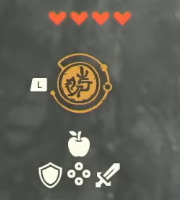
So the Tear that Zelda/Incarnation Zelda have has the ZONAI symbol for the rune “Recall” on it, AKA the rewind rune thing.

HOWEVER. The tear that SIDON wields has the ANCIENT SHEIKAH eye on it

Meanwhile this tear that Tulin wields had a different symbol entirely that I haven’t yet placed...HOWEVER, I am personally bettering that the tears that Tulin and Teba have (presumably also Riju and Yunobo) are Sheikah made, and that the tear Zelda has is Zonai associated. I am MAINLY basing this on my instinct that Zelda is being manipulated by the Easter Bunny Zonai man, who is seen in the cave drawings with all of the tears in his possession, and therefore these Sheikah tears were made in opposition to that power ESPECIALLY since
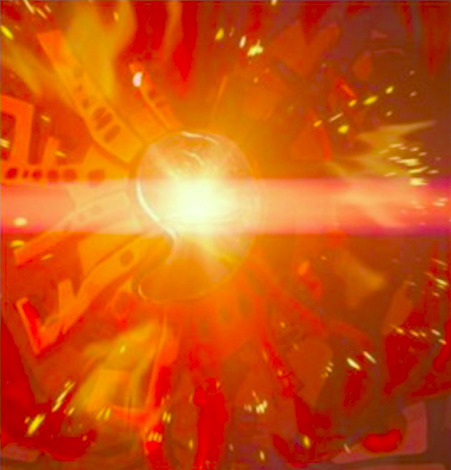
we see ganondorf (hydrated edition) wielding a tear on his forehead. and this other guy

has the malice particles around them, and they have a closed third eye on their forehead with the same 3 eyelash motif as the Zonai carvings. Not sure if they’re working together, more likely given the narrative of cyclic violence and legacy that totk seems to be going for, it could be that these two are fighting to possess the same tear power, and that struggle is rippling out (much like how a tear drop ripples out to affect everything around it in the water) and causing chaos in the rest of hyrule. perhaps the ancient sheikah--devoted to hylia--made their own tears to fight against them, and the zonai perhaps are devoted to demise since we see him also in the trailer kinda but i’ll make a more coherent theory when i get the time that’s just my latest observations here. two different types of tears me thinks <3
33 notes
·
View notes
Text
I have tons of headcanons about Regulus that I can't resist using even when the fic is not about him. Case in point: In the Shadow of Grimmauld Place. He's been dead for over a decade, but did that stop me from writing a scene that takes place in his bedroom and filling it with easter eggs from my Regulus-centric fics?
Nope. Not one bit.
Under the "keep reading" because this gets long and a bit spoilery.
“This would’ve been his seventh year,” he said. “The Warrington girl wasn’t on the team when your father and I left school.”
in reference to the photo of the Quidditch team. Addie Warrington is one of my OCs, a Slytherin girl who was in her third year during Regulus's seventh. She appears in To the Dark Lord as one of his Quidditch teammates, and in Reborn from the Ashes as one of his N.E.W.T. students when he ends up teaching at Hogwarts.
“Was he …” Harry hesitated, like he wasn’t sure he ought to ask. “Was he already a Death Eater then?”
“Yes.”
It was hard to believe. He looked so young and innocent in the picture, so carefree, smiling and waving with his friends.
“I don’t know exactly when it happened, but I know he was sixteen at his initiation. One of the youngest ever. Bellatrix was very proud of that.”
This is canon; he joined at sixteen according to Kreacher, so he would have been a Death Eater while still at Hogwarts. But the reference to being one of the youngest ever comes from To the Dark Lord, and so does the idea that Bellatrix was involved.
A trunk filled with textbooks, old school uniforms, and Quidditch gear, never fully unpacked after seventh year.
In pretty much all of my fics where it's relevant, he goes to the inferi cave the summer after graduating from Hogwarts.
A desk stocked with spare parchment, and a quill with dried ink on its tip still lying on the desk beside an open inkwell, with a couple of drops of black ink dried on the desk nearby.
“That’s not like him,” Sirius muttered, picking it up and holding it carefully between his fingers. “He was very particular about keeping things neat and tidy.”
He wondered what sort of note his brother had been writing when he left, never to return. But, of course, they would probably never know.
More of a canon reference than anything else; y'all know what he was writing, right?
In a small box at the foot of the bed, Sirius packed up the chess set the two brothers used to play with, a tarnished prefect badge, an old copy of Tales of Beedle the Bard, and the photo of the Slytherin Quidditch team, along with a few other small mementos. Nobody challenged him on that. Nobody questioned why he might want to hold onto anything that reminded him of someone he supposedly hated.
The chess set - there are chess motifs everywhere in my Regulus fics, particularly Toujours Vivant and A Little Bird Told Me.
The prefect badge - he's a prefect in To the Dark Lord
“Your brother studied Ancient Runes?” Harry asked, standing beside the bookshelf and leafing through a leatherbound book.
“Yeah.”
My Regulus is an Ancient Runes nerd. It's his second-best subject after D.A.D.A., and it's what he ends up teaching when he becomes a Hogwarts professor in Reborn from the Ashes. He also uses his knowledge of runes on several occasions in Toujours Vivant and accidentally time travels via a rune ritual in The Enemy of My Enemy.
“Do you mind if I take a few of these for Hermione?” he asked. “I’m sure she’d think they’re interesting.”
“Yeah - wait, no, I doubt she’d like that one,” said Sirius, frowning. “That’s a book on very Dark rune rituals. But sure, I think there’s some old runic poetry, and this one” - he lifted a heavy volume with a dark green cover from the shelf - “is all about using runes to create magical objects. We actually used the school’s copy when we were making the Marauders’ Map.”
In Toujours Vivant, the magic Regulus uses to deactivate his Dark Mark is adapted from a Dark Arts rune ritual. Sirius knowing Ancient Runes comes from that fic as well.
A few moments later, Harry was flipping through another book, with his brow furrowing more and more as he looked at it. Sirius couldn’t imagine why. There wasn’t much on these shelves more harmless than Quidditch Teams of Britain and Ireland.
“My God, that’s horrifying,” Harry murmured.
Ah. Not a book about Quidditch, then, unless he was horrified by the Chudley Cannons’ losing streak.
The school-age wannabe Death Eaters hide Dark Arts texts behind innocent-looking covers in May These Memories Break Our Fall and To the Dark Lord. Regulus is also able to figure out Quirrell is doing the same in Reborn from the Ashes.
Sometimes he disguises Muggle literature as spell books, too. He likes Edgar Allan Poe, but he'd never admit it.
“You don’t think your brother made one, do you?” asked Harry.
“No.” Sirius’s voice was sharp and decisive. “Never. That’s … no, horcruxes are a whole other level of evil. The sort of thing the grown-ups in our family warned us about when they first gave us the ‘using the Dark Arts responsibly’ talk.”
Kingsley burst out laughing.
“Is that really something your family did?”
“Yeah. I was ten.”
The Blacks warning their children against creating Horcruxes is a thing in pretty much all of my fics where it's relevant. I've also used the headcanon of them sitting their kids down just before Hogwarts age and giving them a talk about using the Dark Arts responsibly several times, especially in Toujours Vivant and To the Dark Lord.
4 notes
·
View notes
Text
What is Crucible?
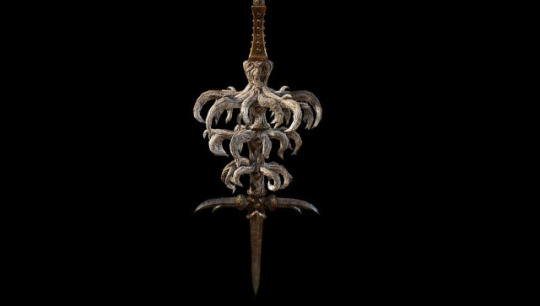
Crucible is one of the most important part of the Elden Ring lore, but the game never explains the exact nature or the form of it. Or does it?
From description of Siluria’s Tree (the primordial form of the Erdtree is close in nature to life itself, and this spear, modeled on its crucible, is imbued with ancient holy essence) we can learn that it is supposed to portray Crucible. I’ve been bothered why the spear is called a tree and turns out translators missed “spear” 槍 in シルリアの樹槍, so it’s Siluria’s tree spear or Siluria’s wooden spear if I go with 樹 archaic form. Interesting that 樹 originated from Old Chinese 尌 which means “a hand planting a tree”.
Knowing that Siluria’s spear isn’t exactly a tree, I decided to rotate it and you can see the result on the picture above.
Here comes my theory - Crucible isn’t a tree, a literal crucible or something else, the last known form of the Crucible is a root system, currently known as Great Roots.
Why do I call it the last known form?
Description of Siluria's tree spear says that Crucible is a part of the Erdtree, but usually game refers Crucible as the primordial form of the Erdtree:
Holds the power of the crucible of life, the primordial form of the Erdtree (Crucible Axe Set)
Description of the Guilded Shield also provides some interesting info:
The red tinge in the gold coat mirrors the primordial matter that became the Erdtree.
As I speculate in my Color Theory post, the life on the Lands Between most likely originated from the golden star, which was sent by the Greater Will (it's also supported by Hyetta's dialogue about births and souls).
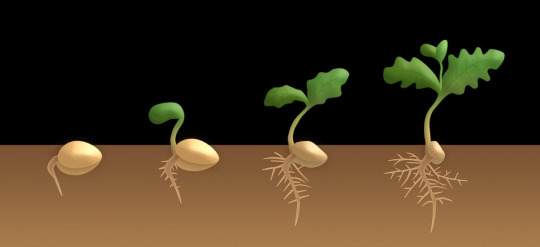
My interpretation is that the golden star is basically is a seed of life is this Evangelion reference? Notably, there is a theme of organic and inorganic matter being not so different (for example: Marika/Radagon's stone flesh), which can be interpreted in a way that golden star primordial matter contained golden ore and fantasy DNA.
In general, my main idea about golden star-the Erdtree evolution looks like this:
Golden star (golden seed) - primordial matter/rudiments of the root system - fully formed Crucible root system/Erdtree's sprout (primordial form) - the Erdtree and remnants of the Crucible (Great Roots)
A quite common motif in architecture from pre-Erdtree period is an imagery of various animals coming from a plant. Divine Tower murals are showing birds, ancient beasts and reptiles intertwined with something floral, similar scenes are depicted in Farum Azula too.

More over, the lead motif is also present in Farum Azula and Nox architecture. I believe Nox and ancient dragons coexisted together for some time, as we know from description of dragonkins items Nox tried to imitate the immortality of the ancient dragons, but failed.
I'd like to thing that this leaf represents Erdtree's sprout.

The roots imagery is a popular theme in Elden Ring too. The tail of the Elden Beast resembles roots, Elden Ring itself used to have root-like rune before Marika's age, roots are shown on the ancient Erdtree's sigil and the giant mural on the Erdtree's entrance.

Roots being assotiated both with life, the Crucible - a place where all life blended together and originated from, but also a death, a place where a souls of dead are supposed to return, follows the theme of duality of life and death. It mirrors the same theme of the red color, a symbol of primordial life and Rune of Death.
Ashes to ashes, what was born from the Great Roots must return to them.
However, both root imagery and red color aren't favored in the modern times, the Erdtree lost its root both on th sigil, but also disconnected from the Great Roots system for the reason unknown (I speculate that it was result of aging of Godwyn's infection). And the red color is commonly viewed as something undesirable and shameful.
[there is a theory of mine that Golden Order not only lacked death, but a life, fertility too, but it's a theme for another post]
And the last, but not the least, cut content:
花の坩堝の乙女、ミランダが この花の最初の一輪であったという
Miranda, the maiden of floral Crucible, is said to be the first of those flowers.
Description of Miranda's Prayer outright says that the Crucible was something floral or plant/flower-alike. For the better or worse, I can't use cut content as a real avidence for my theories, but I wonder if Miranda's flowers used to have a more important role in the story.
#elden ring#elden ring lore#lore theories#crucible#erdtree#cut content#I will reply to asks on weekend#sorry but sumeru was too good#I was even thinking to write lore posts about aranaras#who would win - an intricate story from grrm and miyazaki or the bunch of shroom bois#JP
58 notes
·
View notes
Note
Well actually Vikings did settle in Scotland for some time so Barbara being Scottish with a Viking motif can work. I love the melting pot idea and does tie neatly with Fiesta De Los Muertos and Mount Olympus.
Now I’m thinking that the First King is very well versed in older dialect of Fay Latin compared to modern teensies making him say things that would be out of date haha.
Absolutely. The First King would also know a lot of the cultures and languages that have long since died out in the glade. Not just languages either, this includes the traditions or old lore of ancient past, the species of the glade that are long since extinct. Even translating ancient runes or symbols that would be etched on ruins, or questions in ancient magics.
It is very difficult for a living being to traverse the Land of the Livid Dead safely, so not many tend to seek him or Voodoo Mama out for that reason. When they do make it to the First King's Palace, they often seek him out for advice in the ancient.
Rayman would make a habit of drawing carvings to the best of his ability on a sheet of paper, or taking old tomes to bring the guy to be translated. Rayman and the First King are on very good terms and will always help one another out when the need arises.
4 notes
·
View notes
Text
Thinking about the one-eyed King Irmin mentioned in Hidden Strife.
The writings are as follows: "Remember always that it was the Alberich Clan, who did not have royal blood, who stepped in as regents when the strength of the one-eyed king Irmin failed."
"Though we could not restore Khaenri'ah to life, we of the Alberich Clan should lead lives as those who blaze like fire, rather than those who wallow in the embers
"I saved this one memento from the fire 'Father' made while he wasn't paying attention. This was in violation of our principles. Our clan's affairs should never be recorded.
"Now that I look at it, his handwriting was as grieving as a smoking ash pile. There is no way that I can write something like that, living in Mondstadt as I am."
Irmin is mentioned, in volume 6 of Legend of the Divine Halberds (which you should read if you want to understand my theory)
The first Divine Halberd, Irmin, once pierced the Axis Mundi and connected the nine worlds. Now, its replicas had proliferated across the heavens.
Several of the replicas are spoken of. One of the aforementioned replicas, probably named after the fire god Loki’s weapon, Lævateinn, is further associated with fire.
But unbeknownst to him, this was the greatest cursed sword of all, that had once burned the entire world to cinders: Laevatain. If the fire-realm runes constituted the mystery of the fire realm, Laevatain was its pure unadulterated, unquenchable reality.
The sword had extinguished after the world was burned, but having assimilated the rune of the fire realm, it burned bright once more.
Another of the replicas:
"This is the Sword of Flame, the 'Katakugosha.' It was made from the shard of the Divine Halberd that was the Dharani of the fire realm. Sorry... in language that your Majesty would understand, it's made with the runes of the fire realm, one of the God King's nine realms."
The books also the motifs of blindness of one eye, a father who is not the real father, and the world burning.
As you are aware, a halberd is really a type of polearm, so I am surprised that these nine replicas of the Divine Halberd would be swords. There’s a chance they’re all just weapons, and that that term is used very broadly. I have a theory that Lævateinn/Laevatain is actually the Staff of Homa. Or that the Staff of Homa is one of the replicas.
In real life, Loki, a deity associated with fire, crafts the weapon. It’s unclear what exactly it is; its name means “wounding wand”, “wounding staff”, or “wand of destruction”, but it has also been called a sword, a javelin, and a sure-striking arrow. It is the only weapon capable of harming Víðópnir, the bird (sometimes a rooster, sometimes a falcon) that sits atop the world tree Yggdrasil/Mímameiðr. That’s the same tree as the German “Irminsul” and may represent Celestia, and Venessa who ascended as a falcon to Celestia.
Historically it is attested in the poem Fjölsvinnsmál as such;
"Lævatein is there, that Lopt [Loki] with runes
Once made by the doors of death;
In Lægjarn[Loki]'s chest by Sinmora lies it,
And nine locks fasten it firm"
Sounds familiar, right? The Staff of Homa is described as such in-game.
A "firewood staff" that was once used in ancient and long-lost rituals.
And this is part of its lore. I would encourage you to read the whole thing, if you want to understand.
Though these rites have been forgotten over time and with the coming of peace,
Those with fire in their hearts can still hear these whispered words from flickering flames when they find themselves faced with an imposing darkness:
"Only an unbound flame can purify this world."
#genshin impact#genshin impact kaeya#genshin impact diluc#genshin impact khaenri’ah#khaenri'ah#pavo ocellus
22 notes
·
View notes
Text
Unveiling Viking Bling: A Look at Ancient Nordic Jewelry
Welcome to a fascinating journey into the world of ancient Nordic fashion - specifically, the exquisite jewelry worn by the legendary Vikings. Renowned for their craftsmanship and intricate designs, Viking jewelry not only reflected their artistic prowess but also held significant cultural and symbolic meanings. From elaborate brooches to intricately twisted arm rings, every piece of Viking bling tells a compelling tale of the Norse warriors' beliefs, traditions, and social status.
The allure of Viking jewelry continues to captivate modern admirers, prompting a growing interest in acquiring these timeless pieces. Whether you are eager to add a touch of Viking mystique to your wardrobe or are a passionate collector seeking authentic replicas, exploring the diverse options to buy Viking jewelry is an exciting endeavor. With a myriad of online and offline outlets offering a wide selection of stunning pieces, shopping for Viking jewelry presents a delightful opportunity to indulge in the allure of ancient Nordic craftsmanship.
History of Viking Jewelry
Vikings were skilled craftsmen known for their exquisite jewelry pieces which often symbolized status, wealth, and power. They crafted their jewelry using a variety of materials such as gold, silver, bronze, and precious gems. Each piece was intricately designed and held significant cultural and religious meanings.
Viking jewelry was not only worn for aesthetic purposes but also as a form of protection and to showcase social hierarchy. It was common to find intricate brooches, arm rings, necklaces, and rings adorned with symbols like Thor's hammer, serpents, and runes, reflecting their beliefs and values. These items were not only beautiful but also functional, carrying spiritual significance and serving as amulets for protection in battle.
The popularity of Viking jewelry is evident in the archaeological findings across Scandinavia and beyond. These artifacts offer valuable insights into the craftsmanship and artistry of the Vikings, showcasing their intricate metalworking techniques. Viking jewelry continues to fascinate people today, with a resurgence in popularity leading to a demand for authentic pieces that capture the essence of this ancient Nordic craftsmanship.
Types of Viking Jewelry
Viking jewelry included a variety of pieces that were both functional and ornamental. Necklaces were popular, often featuring intricate designs and symbols. Bracelets and arm rings were also common among the Vikings, sometimes adorned with runes or animal motifs. Rings were another staple of Viking jewelry , with some being intricately detailed while others were simple in design.
Brooches were another important type of jewelry worn by the Vikings. These items were not only decorative but also practical, used to fasten clothing together. The Vikings also wore intricate pins and hair sticks, often elaborately carved or decorated with precious stones. Earrings were worn by both men and women, with some featuring elaborate designs inspired by Norse mythology.
Amulets were considered to have magical properties and were worn for protection and good luck. These pendants were often crafted with symbolic shapes such as axes, hammers, or animals. Belts and buckles were also adorned with intricate metalwork, showcasing the craftsmanship and attention to detail that characterized Viking jewelry.
Where to Find Authentic Viking Jewelry
When seeking authentic Viking jewelry, one recommended avenue is visiting reputable museums with extensive collections of ancient Nordic artifacts. These institutions often offer carefully curated pieces available for purchase, allowing enthusiasts to own a genuine part of Viking history.
Alternatively, specialized online stores dedicated to Viking culture and history provide a convenient platform to browse and buy authentic jewelry. These websites source their products from skilled artisans who craft pieces inspired by traditional designs, ensuring both quality and historical accuracy for buyers.
For those looking to purchase Viking jewelry in person, attending historical reenactment events or market fairs can be a rewarding experience. These gatherings often feature vendors with a selection of handcrafted items, including jewelry, offering a unique opportunity to acquire authentic pieces directly from artisans passionate about Norse craftsmanship.
1 note
·
View note
Text
Unveiling Viking Bling: A Look at Ancient Nordic Jewelry
Welcome to a fascinating journey into the world of ancient Nordic fashion - specifically, the exquisite jewelry worn by the legendary Vikings. Renowned for their craftsmanship and intricate designs, Viking jewelry not only reflected their artistic prowess but also held significant cultural and symbolic meanings. From elaborate brooches to intricately twisted arm rings, every piece of Viking bling tells a compelling tale of the Norse warriors' beliefs, traditions, and social status.
The allure of Viking jewelry continues to captivate modern admirers, prompting a growing interest in acquiring these timeless pieces. Whether you are eager to add a touch of Viking mystique to your wardrobe or are a passionate collector seeking authentic replicas, exploring the diverse options to buy Viking jewelry is an exciting endeavor. With a myriad of online and offline outlets offering a wide selection of stunning pieces, shopping for Viking jewelry presents a delightful opportunity to indulge in the allure of ancient Nordic craftsmanship.
History of Viking Jewelry
Vikings were skilled craftsmen known for their exquisite jewelry pieces which often symbolized status, wealth, and power. They crafted their jewelry using a variety of materials such as gold, silver, bronze, and precious gems. Each piece was intricately designed and held significant cultural and religious meanings.
Viking jewelry was not only worn for aesthetic purposes but also as a form of protection and to showcase social hierarchy. It was common to find intricate brooches, arm rings, necklaces, and rings adorned with symbols like Thor's hammer, serpents, and runes, reflecting their beliefs and values. These items were not only beautiful but also functional, carrying spiritual significance and serving as amulets for protection in battle.
The popularity of Viking jewelry is evident in the archaeological findings across Scandinavia and beyond. These artifacts offer valuable insights into the craftsmanship and artistry of the Vikings, showcasing their intricate metalworking techniques. Viking jewelry continues to fascinate people today, with a resurgence in popularity leading to a demand for authentic pieces that capture the essence of this ancient Nordic craftsmanship.
Types of Viking Jewelry
Viking jewelry included a variety of pieces that were both functional and ornamental. Necklaces were popular, often featuring intricate designs and symbols. Bracelets and arm rings were also common among the Vikings, sometimes adorned with runes or animal motifs. Rings were another staple of Viking jewelry, with some being intricately detailed while others were simple in design.
Brooches were another important type of jewelry worn by the Vikings. These items were not only decorative but also practical, used to fasten clothing together. The Vikings also wore intricate pins and hair sticks, often elaborately carved or decorated with precious stones. Earrings were worn by both men and women, with some featuring elaborate designs inspired by Norse mythology.
Amulets were considered to have magical properties and were worn for protection and good luck. These pendants were often crafted with symbolic shapes such as axes, hammers, or animals. Belts and buckles were also adorned with intricate metalwork, showcasing the craftsmanship and attention to detail that characterized Viking jewelry.
Where to Find Authentic Viking Jewelry
When seeking authentic Viking jewelry , one recommended avenue is visiting reputable museums with extensive collections of ancient Nordic artifacts. These institutions often offer carefully curated pieces available for purchase, allowing enthusiasts to own a genuine part of Viking history.
Alternatively, specialized online stores dedicated to Viking culture and history provide a convenient platform to browse and buy authentic jewelry. These websites source their products from skilled artisans who craft pieces inspired by traditional designs, ensuring both quality and historical accuracy for buyers.
For those looking to purchase Viking jewelry in person, attending historical reenactment events or market fairs can be a rewarding experience. These gatherings often feature vendors with a selection of handcrafted items, including jewelry, offering a unique opportunity to acquire authentic pieces directly from artisans passionate about Norse craftsmanship.
1 note
·
View note
Text
Wk 16, 24th of May, 2024
Divination as a generative process
Recently, I have been using online divination sources as a process of making work/making the poetic notational processes of my practice.
I did a fortune telling session online using rune tiles, where you ask your question inside you mind to yourself and it will be answered through runes and a meaning will be given. Notably, I pulled the lake, or river, rune of feminine laguz. Following this experience I received guidance of spiritual endeavours and journeys. Using this system of knowledge through digitised divination, I compiled my emotional reactions into poetic notation through a small poem book titled laguz for the rune I pulled.
Laguz comes from the ancient roman and greek word for water and speaks on the need to be flexible, bending and soft: all traits academically associated with the divine feminine by eco feminist artist's such as Judy Chicago in her analysis of "haze" and "hazing the landscape" to feminise that space (1970, performance work).

(image of rune use in person, showing fortune telling in the form of runes are traditionally physical matter with inscriptions of the runes etched into stone like shapes and are pulled by the person receiving their divination).
Here is expects from my poem book laguz:

from poem book laguz

from poem book laguz

from poem book laguz
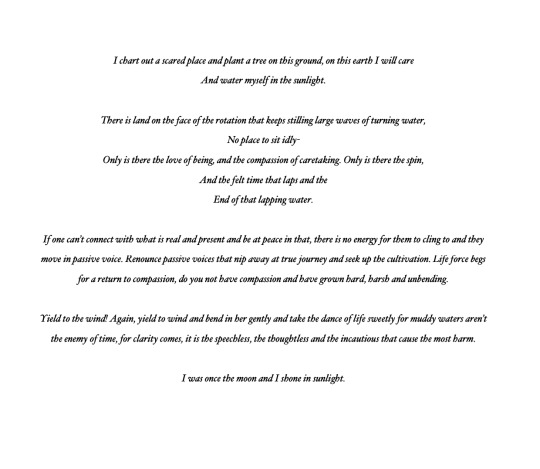
from poem book laguz
I think this work is interesting because it is different from the divinations that could be printed on cards that I was writing earlier, which were more list like poems that focused on words conjuring a visual image. This work is a lot more emotional, it uses nature as a stand in for emotions at times, maybe because of my fear for vulnerability. But I also think the use of motifs such as "plant[ing] a tree", "the moon", "pussywillows", "a parking lot", and the intense emotion is maybe helping these poems feel closer to ideas of embodiment in nature. That by feeling through nature and attributing the languages of things in nature to feelings, these poems are more mystical than some previous poems but also a bit more intense.
0 notes
Text
Unraveling the Viking's Mystique: A Gleaming Look at Their Jewelry Choices
Step into the world of the fearless and legendary Vikings, a people shrouded in mystique and known for their fierce conquests across the seas. While their reputation as warriors and explorers precedes them, a lesser-known aspect of Viking culture that sparkles with beauty and craftsmanship is their exquisite jewelry. Delving into the realm of Viking adornments unveils a treasure trove of intricate designs, symbolic meanings, and a reflection of their rich history and beliefs.
Viking jewelry serves not only as a statement of personal style but also as a powerful symbol of status, protection, and spirituality among this ancient civilization. From intricate arm rings to intricately carved pendants, each piece holds a story waiting to be unraveled. The best Viking jewelry is a testament to the skilled craftsmanship of these seafaring people, showcasing a blend of geometric patterns, animal motifs, and intricate detailing that set them apart in the annals of history. Whether adorned with symbols of Thor's hammer or intricate knotwork, Viking jewelry represents a deep connection to Norse mythology and the natural world that surrounded them.
History of Viking Jewelry
Viking jewelry has captivated generations with its intricate designs and craftsmanship. It is a true reflection of the Vikings' skill and artistry in metalwork. The craftsmanship involved in creating Viking jewelry was highly esteemed, showcasing their mastery in working with materials like silver, gold, and bronze.
The Vikings adorned themselves with a variety of jewelry pieces, each symbolizing different aspects of their culture and beliefs. From brooches to necklaces to arm rings, every piece of jewelry carried its own significance. These accessories weren't just for adornment but also served practical purposes, such as fastening clothing or displaying wealth and status.
With inspiration drawn from Norse mythology and nature, Viking jewelry often featured intricate patterns of animals, dragons, and other mythological symbols. The attention to detail and symbolism in their jewelry reflected the Vikings' strong connection to their beliefs and the world around them.
Symbolism in Viking Jewelry
Viking jewelry carried deep symbolic meanings, reflecting the beliefs and values of the Norse people. One of the most iconic symbols found in Viking jewelry is the Thor's hammer, known as Mjolnir. This powerful pendant symbolized protection and strength, often worn by warriors for its association with Thor, the god of thunder.
Another significant symbol in Viking jewelry is the Valknut, a complex interlocking design suggestive of the interconnectedness of life and death. Warriors believed that wearing this symbol would grant them the favor of Odin, the All-father, in battle, ensuring a swift passage to Valhalla in the afterlife.
Runes, the ancient alphabet of the Norse people, were also commonly incorporated into Viking jewelry designs. Each rune carried its own unique meaning and power, allowing wearers to imbue their jewelry with specific intentions or protection. Whether carved into pendants or bracelets, these runic inscriptions held great significance for the wearer.
Craftsmanship Techniques
The Vikings were known for their exceptional skill in crafting intricate and detailed jewelry pieces. One of the key techniques employed by Viking artisans was filigree work, which involved twisting fine metal threads to create delicate patterns and designs. This meticulous process required a steady hand and keen attention to detail, resulting in stunning pieces that showcased the craftsmanship of the era.
In addition to filigree work, the Vikings also utilized casting techniques to create their jewelry. By pouring molten metal into molds made of clay or stone, artisans were able to produce intricate shapes and designs with relative ease. This method allowed for the mass production of certain pieces, making it possible for a wider range of people to adorn themselves with Viking jewelry.
Another notable technique used by Viking craftsmen was the art of inlaying. This involved setting precious stones, such as garnets or glass beads, into metal settings to create colorful and striking designs. The meticulous process of inlaying required precision and patience, as each stone had to be carefully placed and secured within the metal framework to ensure a secure and beautiful finished piece.
1 note
·
View note
Text
Current Activities in ESO #6
Had to dig for this one. Like Warframe, my last ESO related post was way back in 2014.
My #2 post states my own brother dropped 95$ on the game. 2014 was before I ever ever employed. Jesus.
The origins of Dibbe are revealed. I do remember her still being a dark elf, I still have a screenshot of her as a level 46 being stuck in Coldharbor which eventually drew me away from the game for years after. (I didn't know the guy I had to talk to was just hanging out in the Fighter's Guild there). I've had a pale argonian before on previous games but they were named differently.
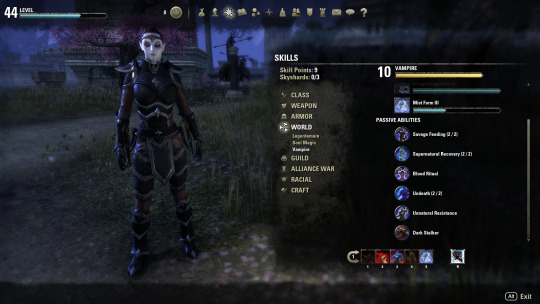
Ancient Dibbe. She's hideous!
My number 5 post basically precedes me quitting the game. Couldn't find my #1 or #4 post.
All of that long before the One Tamriel update. Came back to the game some time ago and all of my problems are basically gone. Leveling still feels just a tad sluggish. 3-10 are usually pretty easy but up into the 40's feels like a slog. Generally one of my better methods is counter to what I usually do on MMO's and I level up as a tank or healer for quicker dungeon queues and just bank on that chunk of experience at the end of them.
After becoming unemployed again I will say that my lack of the craftbag drew me away from the game for a long time. However I've developed something of a system regarding that. I am still painfully selling off some of the harder-to-get materials like runes, but I'm collecting stacks of the more common stuff in my bank. Presumeably to be sold on a guild trader at a later occasion. That way I can still dismantle stuff and it will have a purpose later.
My gaming loop has mostly revolved around collecting decent sets for my various alts. I'm not good at making gold passively, mostly just selling motifs that I get randomly. I keep being told that writs are the moneymaker but that's only a few grand at a time. I wonder if they refer to those master writ you get as rewards sometimes because those typically sell well if you're lucky to get the ones that reward a lot of vouchers. But those aren't guaranteed either.
Dib, my main, is on the cusp of crafting mastery so generally she can craft a couple of decent sets for fresh alts but crafting sets are usually for the beginning. Overland and dungeon sets tend to be improved, so part of my gaming loop is the slow grind of transmutation stones so I can make shit there as well. However a big hurdle there now is without my subscription, I'm now locked out of 80% of the DLC dungeons. I have a few, but I thought dungeons came with the zones that they were released with. I was incorrect. Turns out, ESO content is released quarterly. So I've bought a few zones (I'm missing the Reach which makes me sad because I love that zone and Murkmire, which I don't have much of an opinion on but now I can't make the grave-stake set which I've had fun with in the past).
And I certainly need to keep playing the game because if I run out of gold, it usually means I can't outfit my characters! Transmogging doesn't cost much but still. Gold doesn't make itself.
And then I spend my nights roleplaying. I feel the cusp of a sort of golden age of roleplay for me personally, especially regarding my main girl Dib. I've recently developed a "radiant" quest system. Around 8 of my houses are decorated and can be used for various stealth activities. For most of them (I lose out on decor slots without a sub) I can place a variety of those Precursor dummies, little bland robots that can act as like DnD figurines to represent npc's and enemies (not to mention a few houseguests, I can have up to like 15 npc placements if the decor slots allow). I've put this in practice twice now with a few different people and it's really fun. For the smaller homes it also doesn't even take very long, so it can be used for a thief-to-thief RP meet and greet.
I joined the OG <The Thieves Guild>, a player has owned that tag since 2016 but they're recently staging a revival. It still has a pretty small core right now, about four to five of the same faces have attended the last few events.
I generally, absolutely, detest tavern RP as a general rule but I will resort to it when I'm bored or want to watch a podcast or streamer on the side. However a few nights ago a marshland tavern was opened up in Blackwood, where Dib got to meet a lot of her own kind for once.
As an aside: Not that Argonians don't frequent the current RP hub in Evermore, but I spend most of my time in Evermore wallflowering with nobody deeming my character interesting enough to approach. That or the fact that they're all usually up their own asses to greet newcomers. I had Dib try to contribute to a "never have I ever" and she was never directly replied to once. It felt like four people had me on ignore for no reason.
But in Blackwood, everything felt pretty organic. I dressed Dib down from her usual shady attire from this;

To the more approachable this;

So either she was more approachable or the energy of the room let to my own Dib having more incentive to interact. A friend even came along and instead of being attached to the hip we would interact, break off to mingle, swing back to each other, and break off again. Like a real party! There was one particular player whom I didn't know very well who seemed to attach herself to Dib's side but it didn't detract too much. It was a great night. Dib is pretty sure she almost got jumped by a couple of Khajiit because she openly purchased a tome of daedric lore right there in the open. She detracted an imperial priest's claim that she is so clearly a shady sneaker.

"...Charming."
I've posted that around in some discords I'm in but I can't help it. I almost died laughing at my computer. I'm even unclear if he bought it or not but she cut real close about openly admitting daedra worship (she's a Nocturnal simp) but I feel like she managed to pull way from it.
While unemployed I'm generally making an effort to pop in relevant RP events I see scheduled in the various discords I'm in. And I do say relevant. I almost attended a pet show, I wanted to bring a small guar that Dibbe named "Lump" and would emote the fact that there was nothing special about it and that she likely just picked it out of a field somewhere. "This is lump he's wonderful" (this Guar isn't special at all). I decided to go for some other open RP in someone's household. I acquired secondhand knowledge that there was no "show" to begin with. People just brought along pets and everyone just walked around to talk about them. Would still have been funny to have Dibbe and Lump just hanging out in the corner somewhere.
Anyway I've been working on this post for an hour with Dib waiting for me in the background to do a Jester Festival quest.
1 note
·
View note
Text
Gods of the Deep: Lovecraft-inspired horror movie

Gods of the Deep is a 2023 H.P. Lovecraft-inspired submarine horror thriller that takes audiences on a chilling underwater adventure. The film follows a team of aquanauts who embark on a daring mission to explore the depths of an Antarctic Trench, where they discover an ancient temple hidden beneath the ocean's surface.
The movie, which has received mixed reviews, is known for its sloppy execution and lack of polish. However, it does offer a unique blend of Lovecraftian horror and underwater exploration, which has piqued the interest of fans of the genre. The film's plot revolves around the team's discovery of runes on the ocean floor, which they should have left undisturbed. As they delve deeper into the temple, they uncover dark secrets and encounter terrifying creatures that threaten their lives.

The lead character in Gods of the Deep works for Miskatonic University, which is a fictional institution that has appeared in many Lovecraftian stories and films. The deep sea explorer team, led by this character, investigates the runes on the ocean floor, unaware of the horrors that await them.
Gods of the Deep is a 2023 H.P. Lovecraft-inspired submarine horror thriller that takes viewers on a terrifying underwater adventure. The film has received mixed reviews, but it offers a unique blend of Lovecraftian horror and underwater exploration that is sure to appeal to fans of the genre.
The film's main character, Jim Peters (played by Derek Nelson), is a daring adventurer who joins a team investigating the appearance of an ancient temple in a newly discovered Antarctic Trench. The team, consisting of Captain Atkins (Tim Cartwright), Makenna Guyler, Rory Wilton, Kane Surry, Rowena Bentley, and David Lenik, is recruited by the Pickman Company, which believes there are important secrets to be uncovered.
As the team descends into the depths of the ocean, they encounter terrifying creatures and uncover dark secrets that threaten their lives. The film is known for its Lovecraftian horror elements, which are combined with underwater exploration. However, the movie has received mixed reviews, with some critics praising its unique blend of genres while others criticize its sloppy execution and lack of polish.
Gods of the Deep H.P. Lovecraft-inspired submarine horror thriller that draws inspiration from the Cthulhu Mythos, a collection of stories and characters created by H.P. Lovecraft. The film's plot revolves around a team of deep-sea explorers who discover an ancient temple hidden beneath the ocean's surface, awakening an ancient race of otherworldly beings. Lovecraft's stories often feature cosmic horror and the unknown, and Gods of the Deep incorporates these elements into its plot, creating a sense of dread and terror as the team delves deeper into the temple. While the film is not an adaptation of any specific Lovecraft story, it draws heavily from the themes and motifs present in his work, making it a Lovecraftian horror film.
0 notes